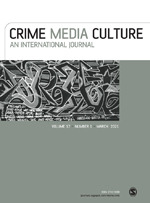
Crime, Media, Culture
An International JournalCrime, Media, Culture is a fully peer reviewed, international journal providing the primary vehicle for exchange between scholars who are working at the intersections of criminological and cultural inquiry. It promotes a broad cross-disciplinary understanding of the relationship between crime, criminal justice, media and culture.
The crime/media/culture nexus speaks to many whose work is embedded in theories of social relations and social change, and therefore maintains high relevance across the full spectrum of social sciences and humanities. Crime, Media, Culture provides a unique and much needed forum for serious debate underpinned by empirically novel and/or theoretically rigorous research.
"Somewhere between criminology and cultural studies in an area of excitement. It is here where the cultural shift is most evident and where a journal like Crime, Media, Culture can provide just the right lens at the right time" Jock Young, John Jay College of Criminal Justice, City University of New York, USA and University of Canterbury, UK
"Crime, Media, Culture acknowledges what so many scholars have long recognized, namely the critical importance of media and cultural representations in shaping popular stereotypes of crime and justice, and thus of official policies. All the better the journal's international nature promises a long overdue integration of existing scholarship in North America, Europe and the Asia/Pacific region. I am delighted to be associated with this project" Philip Jenkins, Pennsylvania State University, USA
Access all issues of Crime, Media, Culture on SAGE Journals Online.
This journal is a member of the Committee on Publication Ethics (COPE).
Crime, Media, Culture is a fully peer reviewed, international journal providing the primary vehicle for exchange between scholars who are working at the intersections of criminological and cultural inquiry. It promotes a broad cross-disciplinary understanding of the relationship between crime, criminal justice, media and culture. The journal explores a range of media forms (including traditional media, new and alternative media, and surveillance technologies) and has a special focus on cultural criminology and its concerns with image, representation, meaning and style. While CMC embraces submissions across a range of research perspectives and methodological orientations, CMC encourages especially work that develops cultural, critical, and qualitative understandings of the crime, media, culture nexus
The journal invites papers in three broad substantive areas:
- The relationship between crime, criminal justice and media forms (including traditional media, new and alternative media, and surveillance technologies)
- The relationship between criminal justice and cultural dynamics (with a special focus on cultural criminology and its concerns with image, representation, meaning and style)
- The intersections of crime, criminal justice, media forms and cultural dynamics (including historical, political, situational, spatial, subcultural and cross-cultural intersections)
While CMC embraces submissions across a range of research perspectives and methodological orientations, CMC encourages especially work that develops cultural, critical, and qualitative understandings of the crime, media, culture nexus. On this basis, while CMC does not reject quantitative studies out of hand, it does require that statistical analysis be substantiated by, and situated within, theoretically informed and qualitatively nuanced engagement with the subject matter. Research predicated largely or entirely on quantitative analysis will perhaps be better submitted elsewhere.
| Jeff Ferrell (Co-Founder) | Texas Christian University, USA and University of Kent, UK |
| Chris Greer (Co-Founder) | University of Essex, UK |
| Yvonne Jewkes (Co-Founder) | University of Bath, UK |
| Sarah Armstrong | University of Glasgow, UK |
| Katherine Biber | University of Technology, Sydney, Australia |
| Travis Linnemann | Kansas State University, USA |
| Avi Brisman | Eastern Kentucky University, USA |
| Michelle Brown | University of Tennessee, USA |
| Eamonn Carrabine | University of Essex, UK |
| David A. Green | John Jay College, The City University of New York, USA |
| Mark S. Hamm | Indiana State University, USA |
| Keith Hayward | University of Copenhagen, Denmark |
| Greg Martin | Murdoch University, Australia |
| Sarah Moore | University of Bath, UK |
| Alison Young | University of Melbourne, Australia |
| Emma Russell | La Trobe University, Australia |
| Bill McClanahan | University of Tennessee, USA |
| Elaine Campbell | Newcastle University, UK |
| Lynn Chancer | Hunter College of the City University of New York, USA |
| Chris Cunneen | Jumbunna Institute, University of Technology Sydney, Australia |
| Michael Fiddler | Greenwich University, UK |
| Bianca Fileborn | University of Melbourne, Australia |
| Jennifer Fleetwood | Goldsmiths, University of London, UK |
| Maria Giannacopoulos | UNSW, Australia |
| Liam Gillespie | University of Melbourne, Australia |
| Jonathan Ilan | University College Dublin, Ireland |
| Theo Kindynis | City, University of London, UK |
| Steven Kohm | University of Winnepeg, Canada |
| Anita Lam | York University, Canada |
| Maggy Lee | University of Hong Kong, Hong Kong |
| Alyce McGovern | University of New South Wales, Australia |
| Eugene McLaughlin | City University London, UK |
| Michael Mopas | Carleton University, Canada |
| Laura Naegler | University of Liverpool, UK |
| Joshua Page | University of Minnesota, USA |
| Anastasia Powell | Royal Melbourne Institute of Technology University, Australia |
| Vladimir Rizov | University of Sussex, UK |
| Sara Salman | Victoria University of Wellington, New Zealand |
| Judah Schept | Eastern Kentucky University, US, USA |
| Lizzie Seal | University of Sussex, UK |
| Gregory J. Snyder | Baruch College, The City University of New York, USA |
| Justin Turner | Illinois State University, USA |
| Tyler Wall | University of Tennessee, USA |
| Kate West | Oxford Brookes University, UK |
| Mark Wood | Deakin University, Australia |
Manuscript submission guidelines can be accessed on Sage Journals.